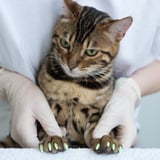Are Claw Caps the Answer for Scratchy Cats? 2 Vets Weigh In on the Pros and Cons
 Get the Full StoryImage Source: Getty Dina Damotseva
Get the Full StoryImage Source: Getty Dina DamotsevaThere's a lot of things to love about cats: their playful nature, sweet purrs, and gentle demeanors first come to my mind. However, I'm pretty confident in saying that their constant scratching and clawing at furniture is not a favorite quality. While this behavior can be extremely frustrating, declawing feline friends is generally unadvised by experts except in rare situations. According to the Humane Society, declawing is known to be quite painful and can lead to infection, lameness, and tissue death.
Still, if you're tired of coming home to find your couch cushion ripped to shreds but youmdon't want to cause long-term damage to your cat, claw caps might be your answer.
Related:
30 Cat Trees That Aren't, Well, F cking Ugly
What Are Claw Caps?
"Claw caps are soft plastic coverings that a pet parent can use on their cat's claws," Shawna Garner, DVM, U.S. lead veterinarian at FirstVet, told POPSUGAR. They're usually applied using an adhesive in the cap, and generally take about 5 to 10 minutes to put on. Better still, owners can apply the claw caps themselves.
"Cats can still go through the natural action of 'sharpening' their claws, scratching items, and even being rough when playing, but the caps prevent them from causing any damage," Dr. Garner explained.
Do Claw Caps Cause Any Pain or Discomfort?
"Some cats may have an adjustment period of a few days. While the caps are not painful, they likely feel 'funny' for your cat to wear at first," Dr. Garner said. However, the caps can be painful if they're applied incorrectly or if your cat is particularly sensitive to the adhesive, Anthony Hall, DVM, MPH, an expert vet at Airvet, told POPSUGAR. For this reason, it's important to watch your cat's behavior for any sign of intense discomfort if you chose to put on claw caps.
Image Source: Getty Dina Damotseva
Do Claw Caps Need to Be Changed Regularly?
Dr. Hall explained that claw caps will likely come off on their own in 4 to 6 weeks however, "If they do not come off on their own, you will need to take them off safely, and then replace them with new ones," he said. Dr. Garner agreed claw caps should be changed monthly.
Are There Any Other Considerations to Take Into Account?
"Scratching is a normal behavior for cats," Dr. Hall explained. While claw caps can prevent the destruction of furniture, Dr. Hall suggests also finding ways to provide safe scratching alternatives such as regular nail trimming and scratching boards.
Dr. Garner advised those eager to try claw caps to make sure there are no obvious signs of injury to the nails or nail beds. If you're unsure, veterinary clinics or grooming facilities can often apply claw caps for a minor fee.
Share: